2011 Trends in Latin America: The Middle Class
December 29, 2011 11:59 am (EST)
- Post
- Blog posts represent the views of CFR fellows and staff and not those of CFR, which takes no institutional positions.
More on:

Another 2011 trend is the rise of the middle class. While in the United States article after article – as well as the country-wide “Occupy Wall Street” protests -- denounced the decline of the middle class, in Latin America the middle continued its gains. Despite the tougher international climate, economic growth averaged over 4 percent, and unemployment rates fell to 6.8 percent (from 7.3 percent in 2010). Perhaps more important, GINI coefficients -- which measure inequality -- lowered slightly to just over 50 (from roughly 53 in 2000). This means that the growth that happened actually spread to the bottom and middle of the pyramid.
There is an ongoing debate about how to measure the global middle class. Some of these issues I addressed in this past post. But whatever the starting point, the 2011 regional trend was positive. In Brazil, the middle topped 100 million, in Mexico it reached 67 million, and in Argentina more than 21 million.
This doesn’t mean Latin American nations don’t continue to struggle with poverty. According to the latest World Bank data, just under 30 percent of the population -- 160 million people -- lives on less than $4 a day (in PPP terms), and 14 percent -- some 80 million -- live in abject poverty (on less than $2.50 a day). The growing middle though does show the path forward, and reinforces the goal for those concerned with the less fortunate, helping them too rise the economic ranks into a more comfortable middle.
More on:
 Online Store
Online Store